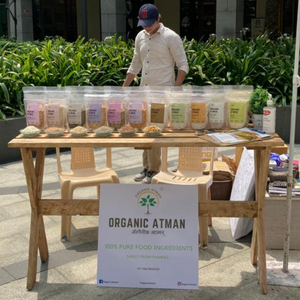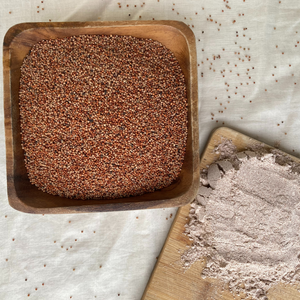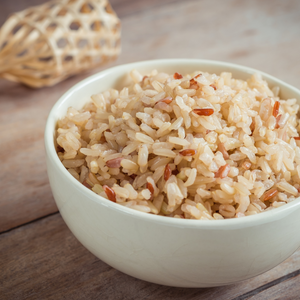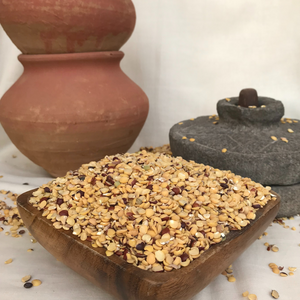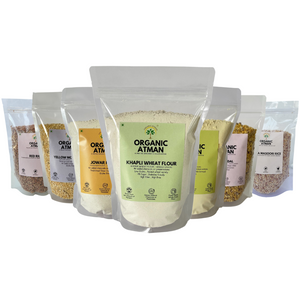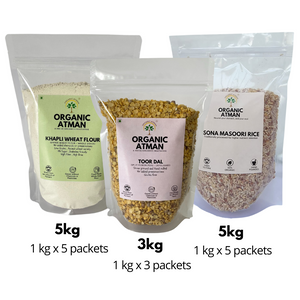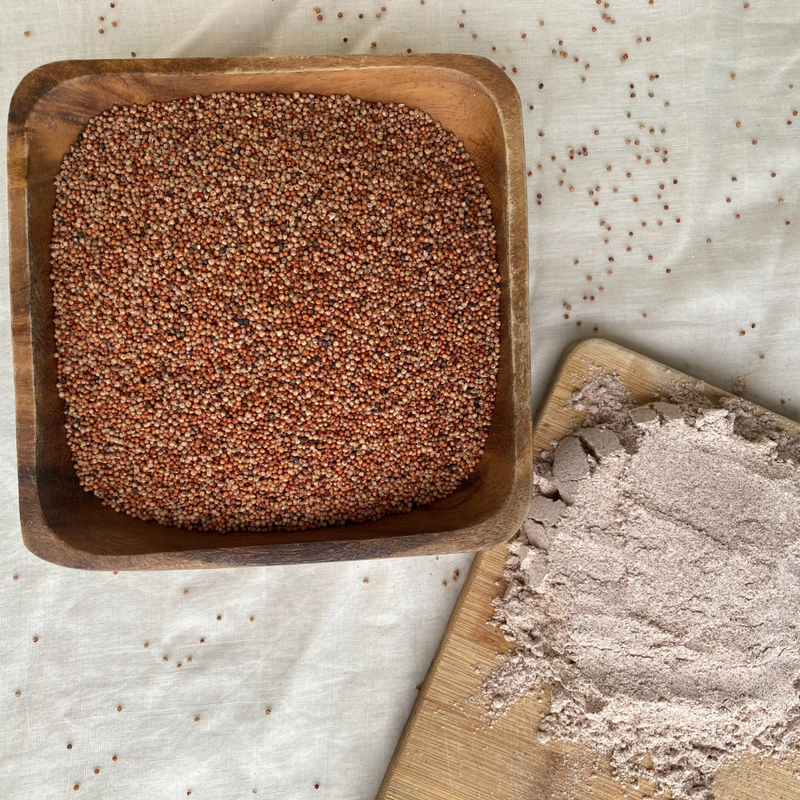As technology advances, people are making more thoughtful and healthful choices. The first step starts with the food we consume. So, whether our goal is to stay consistent on the protein intake, gluten-free diet, or provide better nourishment for your family, it all starts with what’s on your plate.
Every day, we consume wheat in our diet. However, wheat has been viewed negatively in health-conscious circles due to its high gluten content. This is where Khapli wheat comes in, offering a tasty and healthy indigenous grain with numerous health benefits that enhance a balanced diet.



But wait, what is Khapli wheat??
Khapli wheat—also known as “Emmer wheat” or “khapli gehu”—is an ancient, traditionally grown wheat grain, cherished for ages for its amazing health benefits. However, Khapli gehu was forgotten as modern wheat gained popularity until recently; it has been rediscovered due to its lower gluten content, making it easier to digest.
Unlike regular wheat, khapli wheat does not spike insulin levels due to its low glycaemic index; it helps regulate blood sugar levels. Khapli gehu can easily be indulged in in our Indian diet, so whether you’re creating chapatis, breakfasts like paratha or upma, or nutritious snacks, Khapli wheat is a versatile ingredient that brings both taste and nutrition to your meals.
Understand why Khapli wheat?
A concerning issue was brought to light by TOI: wheat’s high selenium content has left many puzzled, especially due to its link to unexplained hair loss in Buldhana, Maharashtra. Dr. Himmatrao Bawaskar, a dedicated researcher, discovered that this wheat contains 600 times the allowable selenium. High selenium levels can lead to selenosis, a serious health condition.
While examining the advantages of Khapli wheat, it is important to take these potential risks seriously. Remember, being aware of the ingredients in our food is crucial to making wise decisions for our health!
So what makes Khapli wheat so special?
ü Lower in gluten
ü Higher in protein
ü Rich in antioxidants
ü Abundant in fiber
ü Packed with essential minerals
Historical Significance
Khapli wheat is one of the earliest grain crops to be grown. Dating back nearly 10,000 years, ‘Khapli gehu’ or ‘emmer wheat’ came to India during the Indus Valley civilisation. Emmer was an important food in Indian and Mediterranean diets. Khapli wheat was valued for being strong and able to grow in difficult conditions. Emmer wheat was widely used in Italy and Egypt during Pharaonic times and was the staple diet of the Roman armies and the labourers who built the pyramids predating the cultivation of modern wheat varieties.
Cultivation in India
Khapli wheat is primarily cultivated around the borders of Karnataka and Maharashtra, where it is also called ‘sadak’ in some regions. Emmer wheat thrives in dry climates with well-drained soil and requires less water than modern wheat. Also, it’s been used in Indian agriculture for thousands of years for its ability to grow in less fertile soils.
Khapli wheat, which was traditionally used to produce rotis and bhakris, went out of favour during the Green Revolution as farmers chose high-yield cultivars. However, Khapli wheat is gaining popularity, especially among health-conscious consumers seeking natural and chemical-free alternatives to modern wheat varieties.

Why is Khapli wheat a better alternative than regular wheat?
Khapli wheat is distinct from ordinary wheat by its lengthy, basmati-like grains. Khapli wheat flour, or atta, is made using traditional techniques, such as de-husking, sun-drying, and stone-grinding, which lower the gluten content while maintaining the germ and nutrients. Emmer can be introduced in a diet in the form of chappati’s, bhakri’s, laddoos, healthy snacks, porridge, and much more.
Khapli Wheat Flour Benefits
1. High in Nutrients
Khapli wheat is rich in dietary fiber, protein, antioxidants, iron, and magnesium. It helps with digestion, boosts energy, and supports overall health.
2. Low in Gluten
Cultivators of Khapli wheat assert that it contains only five to six percent gluten, in contrast to other varieties such as Sharbati, Sinhore, and Lokwan, which typically have gluten levels ranging from eight to ten percent, making it easier to digest and a great option for those with mild gluten sensitivity.
3. Helps with Weight Management
Khapli wheat has a low glycaemic index, meaning it releases energy slowly. This keeps your stomach full for longer, reduces cravings, and helps regulate blood sugar levels.
4. Suitable for Diabetics
Unlike ordinary wheat, Khapli wheat helps to regulate blood sugar levels. Consuming food containing emmer may be a healthier alternative for diabetic patients.
5. Easier to Digest
Many people experience bloating with regular wheat. Khapli wheat’s high fiber content promotes better digestion and gut health.
6. Supports Heart Health
Regular consumption of Khapli wheat helps lower cholesterol and reduces the risk of heart disease.
7. Ancient & Unprocessed
Unlike current hybrid wheat, Khapli wheat has remained natural, conserving its original nutrition.
8. Superior Taste & Soft Texture
Rotis made with Khapli atta are soft, a little salty in taste, and stay fresh longer.
How to use Khapli Atta in your diet?
Khapli wheat flour/atta differs from regular flour, which is produced through traditional methods. But it is very simple and versatile to consume. Rotis made with Khapli wheat are just as soft as those made with regular wheat, though they are a few shades darker and have a mildly nutty flavour.
1. Chapatis and Rotis
Swap regular wheat flour with Khapli flour. Use ghee to knead and to make soft, healthy chapatis or rotis with a mild, nutty flavour.
2. Breads and Cakes
Emmer flour can be used for baking bread, cakes, or muffins.
3. Cookies and Biscuits
A healthier alternative to cookies or biscuits with Khapli flour, offering a guilt-free, tasty snack.
4. Porridge
Khapli wheat is light and nourishing that can be introduced as breakfast for kids and elders through wholesome Khapli wheat recipes like Upma, paratha, porridge, etc.

Where Can You Buy Khapli Wheat and Khapli Wheat Flour?
Khapli wheat and Khapli wheat flour are both commonly available online and at retail locations. For those seeking a reliable source, Organic Atman provides high-quality Khapli wheat and Khapli wheat Atta/flour that has been minimally treated to keep its natural flavour and nutritional value.
We track the journey of every Khapli wheat grain from farmer to us and ensure that you receive freshly milled Khapli atta at your door.
Why Choose Organic Atman?



At Organic Atman, we consider food to be the foundation of wellness rather than only fuel. Our journey started when Vedant Godbole, our founder, used holistic diet to overcome an autoimmune illness. This personal change motivated an effort to provide something better when harmful practices in traditional farming were discovered.
Organic Atman is a farm-to-fork company committed to providing wholesome, toxin-free food that is based in tradition and the goodness of nature. By prioritising transparency in all aspects of our operations, including sourcing and packaging, we are creating a conscious community that values honesty, authenticity, and good nutrition. Our objective is to make organic food available to everyone while promoting sustainable farming through the use of ancient grains, traditional processing techniques, and clean ingredients
FAQ’s
1. What is Khapli wheat?
Khapli wheat, also known as Emmer wheat, is an ancient grain valued for its rich nutty flavour and high nutritional content.
2. How is Khapli wheat made?
Khapli wheat is grown naturally and stone-ground to retain its rich nutrients and authentic taste.
3. What does Khapli wheat look like?
The grains are long, like basmati, and reddish-brown, slightly darker than regular wheat, with a dense texture.
4. Where is Khapli wheat grown in India?
It is mostly grown in regions like the borders of Maharashtra, Karnataka, and other southern regions.
5. What is Khapli wheat called?
It is also referred to as Emmer wheat, Khapli gehu, Sadak, Farro, and Khapli atta when made into flour.
6. Is Khapli atta good for pregnant women?
Yes, Khapli atta is high in iron and magnesium, making it an ideal meal option for pregnant women or those in the postpartum period. However, pregnant women should always speak with a healthcare physician or nutritionist before making significant dietary changes to ensure that they satisfy their specific health needs.
7. Is Khapli wheat suitable for diabetics?
Absolutely, its low glycaemic index helps regulate blood sugar levels, making it very suitable and diabetic-friendly. However, it's important for individuals with diabetes to consult with a healthcare professional or nutritionist before incorporating new foods into their diet to ensure it aligns with their specific health needs and management plan.
8. How can I use Khapli wheat in daily cooking?
You can use it to make chapatis, porridge, baked goods, or even as a thickener for soups and gravies. It is a grain similar to wheat but with less gluten and more nutrients. Chapatis made with Khapli are much tastier.
9. Who should not eat Khapli wheat?
Khapli wheat has advantages, but not everyone is a good fit for it. The needs of your body are different. Those with coeliac disease, IBS, gluten sensitivity, or wheat allergy should also exercise caution. Khapli is sometimes simpler to digest than contemporary wheat, but if you have any health issues or food sensitivities, always consult your doctor.
10. Where can I buy Khapli wheat?
Khapli wheat is available online and in retail stores. For a high-quality organic option, Organic Atman provides a trusted choice. We access traditionally grown, chemical-free Khapli gehu and deliver fresh flour to your doorstep.
Experience the benefits of Khapli wheat yourself here.






